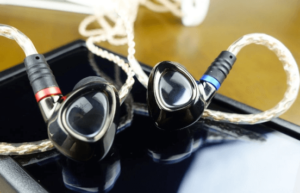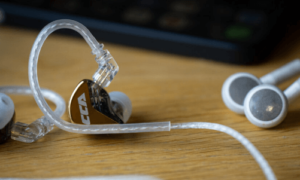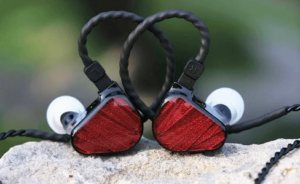IEM and earbuds are generally used interchangeably. However, there are some essential differences between IEMs and earbuds that you should be aware of.
Are IEMs better than earphones? IEM vs Earbuds
In-Ear Monitors and Headphones: Which is Right for You?
Sound quality: Both IEMs and headphones can provide high-quality sound, but IEMs generally provide more accurate and detailed sound due to their in-ear design.
Comfort: IEMs are more comfortable to wear for long periods of time than headphones because they do not put pressure on your ears.

What is the difference between IEM and Earbuds?
Earbuds and IEMs are similar in that they are both small, portable audio devices that are inserted directly into the ear. The biggest difference between the two is that IEMs are inserted into the ear canal while earbuds are placed in the outer ear.
This is not the only difference between these devices, most of the other major differences stem from them. The difference between IEMs and earbuds is vague and somewhat confusing. It’s much more ambiguous than the difference between headphones and headsets.
At first glance, it’s easy to mistake IEMs and earbuds for the same thing. Ultimately, both are small, portable audio listening devices that fit into your ears.
But here’s the biggest difference. As the name suggests, in-ear monitors (IEMs) are placed directly into the ear canal, while earbuds are simply positioned in the outer ear.
This difference may seem minor at first, but it has many implications, which we will now list.
Who is it made for?
IEMs (in-ear monitors) are earphones used by audiophiles, composers, audio engineers, and live performers. It is made of high-quality materials such as acrylic, metal, and resin along with plastic.
As the name suggests, it’s mounted inside the ear canal, allowing you to monitor audio, mix and master tracks, listen to music with exceptional clarity, and more.
Earbuds like AirPods are made for the masses and are used by almost everyone. It is mounted on the outer ear and has an all-plastic body, making it lightweight and ideal for long-term listening.
Because earbuds are made for the general public, they usually come in standardized shapes and sound configurations.

IEM vs Earbuds:
Comfort
The general consensus is that the earbuds are the consistently more comfortable option of the two, as they follow the one-size-fits-all approach already mentioned. In theory, this makes sense, but since earbuds are often all plastic, it can be kind of hit or miss.
Models with rubberized ear wings or other types of fitting mechanisms can definitely help. But most earbuds that come free with other devices are anything but comfortable.
Alternatively, IEMs can be very comfortable, but like noise isolation, they are predicated on using the right tips and forming a proper seal.
High-quality IEMs come with a variety of eartips to choose from, and you can always order aftermarket solutions or custom-fit them. But this brings us closer to apples and oranges territory.
Here we’re comparing a high-end IEM with all of these options to a budget earbud (because it’s really the only kind of earbud). It’s not right.
Ultimately, we all have different and unique ear canals. Some people will find it intolerable to use IEMs, regardless of the quality of the eartips or device.
That’s why it’s best to test these things yourself.
Better Noise Isolation
Because IEM tips fit inside the ear, they provide better passive noise isolation and are less likely to fall out of the ear (if they fit well).
Along with regular silicone eartips, they also come with memory foam eartips and special two- or three-pronged eartips to provide a proper seal and a firmer grip.
All these efforts to block out ambient noise are necessary for live performers because stages can be really loud and prolonged exposure to that noise level can cause chronic tinnitus.
In fact, IEMs were designed specifically for band members who couldn’t hear themselves playing because of the crowd’s cheering!
For any performer, a reliable pair of IEMs is an investment in their career. After all, you can’t afford to ruin the show just because your earphones are terrible. This is why IEMs are built to have much better passive noise isolation than most earbuds.
However, most wireless earbuds offer active noise cancellation (ANC), which blocks more noise than passive noise cancellation. However, ANC is not ideal for everyone as it can hurt your ears and cause dizziness.
If you want the best noise isolation possible, you can do like a musician and buy IEMs custom-made for your ears.
This product called a custom in-ear monitor, fits your body better than any other earphone in the world.
Unfortunately, it is a very expensive product, costing over $1,000. Most people shouldn’t spend this much money on IEMs, but CIEMs are the ultimate gift for wealthy audiophiles.

Volume
The closer the source of the sound (in this case, the driver) is to your ear, the more likely it is that your hearing will be damaged.
This won’t happen if you don’t listen to music at excessively loud volumes, but the problem is that the reason we often turn up the volume has nothing to do with the music itself.
You often need to turn up the volume to drown out ambient noise, IEMs essentially act as earmuffs once they form a proper seal, greatly reducing ambient noise.
As we discussed, earbuds sit in the outer ear and do not block the ear canal, allowing a lot of ambient noise to enter.
So, if you are using earbuds in a noisy environment, you have no choice but to turn up the volume. Even so, you probably won’t be able to eliminate all unwanted background noise.
On the other hand, IEMs allow you to listen at lower volumes, but you can hear your music better because the surrounding noise is not a big obstacle to overcome. This is why IEMs have become an essential part of the toolkit of every gym-goer.
They clip onto your ears and allow you to listen to music while blocking out music playing in the background. This goes both ways. Sometimes you want to stay aware of your surroundings, like when you’re jogging, or you want to hear traffic.
In this case, earbuds often come out on top, although higher-end IEMs have an ambient mode to keep you aware of your surroundings.
Driver configuration
In-ear monitors typically contain multiple drivers. Earbuds often have only a single dynamic driver. As a result, IEMs can each have multiple drivers. Dynamic drivers are usually there to handle the bass, but the mids and treble often have their own balanced armature drivers, sometimes multiple.
It is not uncommon for IEMs to boast more than five drivers. As you can imagine, the clarity and precision that these five drivers can achieve will always be better than the single driver found in most earbuds.
This doesn’t mean that there aren’t IEMs that only offer a single driver. As already mentioned, IEMs cover all price ranges, from budget choices to high-end, audiophile-grade, and even professional models.
This is why we don’t like to use driver configuration or sound quality as the main factor in determining what makes an earbud or IEM (some other sources do the same, but more on that later).

Better sound quality
Five consecutive IEM images courtesy of Joshua Valor
Because IEMs are built for audio monitoring purposes, they offer greater clarity, detail, depth, and clarity than most earbuds. And because they have better passive noise isolation, they sound louder.
Often, we turn up the volume on our earphones not because they are not loud enough, but to drown out ambient noise.
Many audiophiles recommend IEMs over earbuds. Because IEMs allow you to hear the song as the artist intended, i.e. without any “coloring”. As you know, earbuds typically have a V-shaped sound signature.
That is, it is geared toward a pleasant and upbeat sound, but not necessarily detailed and pure. Think Beats by Dre, Skullcandy, Galaxy Buds, and AirPods.
However, when performing on stage or recording a track in the studio, it is important to be able to judge all aspects of the track.
Every beat, nuance, and texture of a song must be represented accurately to avoid misunderstanding or stuttering. Unfortunately, earbuds don’t offer this level of detail.
Another big difference is that earbuds only come with dynamic drivers, while IEMs come with different types of drivers.
As you can see, dynamic drivers tend to handle lower frequencies (bass and sub-bass) well, but not as well at higher frequencies (treble).
In earbuds, the dynamic drivers have to process all frequencies (bass, mids, and treble) on their own, which is not efficient.
But by using a combination of dynamic and balanced armature drivers (and other rare varieties), IEMs spread the workload.
This allows specific frequencies to be assigned to the appropriate drivers, resulting in cleaner, more accurate sound.
Convenient
The earbuds are cable-free and can be easily carried via case, giving you more freedom of movement. However, it is also true that IEMs are less likely to fall off or get lost because they sit more securely in your ears.
Additionally, in-ear monitors don’t need to be charged, but earbuds need to be charged every day.
Don’t forget that since earbuds are always charging or 100% charged inside the case, they will degrade very quickly. This is not good for lithium-ion batteries.
The earbuds have a transparency mode for an always-on experience so you don’t have to take them off, but if you’re talking to someone directly, you’ll probably want to remove them anyway.
One of the great things about the earbuds is that they feature Environmental Noise Cancellation (ENC), which uses AI to block out ambient noise during phone calls, allowing the person on the other end to hear you more clearly.
However, this feature is usually only found in expensive, high-end earbuds.
So should you buy a pair of IEMs?
Well, not necessarily. This entirely depends on you and your listening preferences, budget, and lifestyle. For most people, earbuds get the job done very effectively and are easy to use and convenient to carry.
Plus, a good pair of IEMs costs more than the average $20 pair of earbuds. So buying IEMs can be a bad decision if you don’t know what you’re doing.
In comparison, earbuds are an easy choice if you don’t care about all the technical details and just want something that works well enough.
That said, if you’re interested in audio and want to try something new, you should get some in-ear monitors. They generally sound better in terms of detail, last longer, fit more comfortably, and come in all shapes, sizes, and configurations.

Are IEMs worth the money instead of earbuds?
If you are considering purchasing an IEM after reading all of the comparisons above, we have good news for you.
IEMs were expensive because they were originally intended only for artists, professionals, and engineers, not the general public.
However, recently, with the entry of Chinese manufacturers, IEMs have become ridiculously cheap. These days, you can find a decent pair of IEMs for under $30.
And for the price of AirPods, you can get professional IEMs with much better sound quality and durability.
Are IEMs safer than earbuds?
Compared to earbuds, in-ear monitors (IEMs) can be a safer option for listening to music for long periods of time.
Can IEMs be used as earbuds?
Yes, IEMs are earbuds with different shapes to make them more comfortable to wear for long periods of time. They often sound better than cheap store-bought earbuds.
IEMs that wrap around the ears are also great when doing rigorous exercise without fear of the earbuds falling out of your ears.
